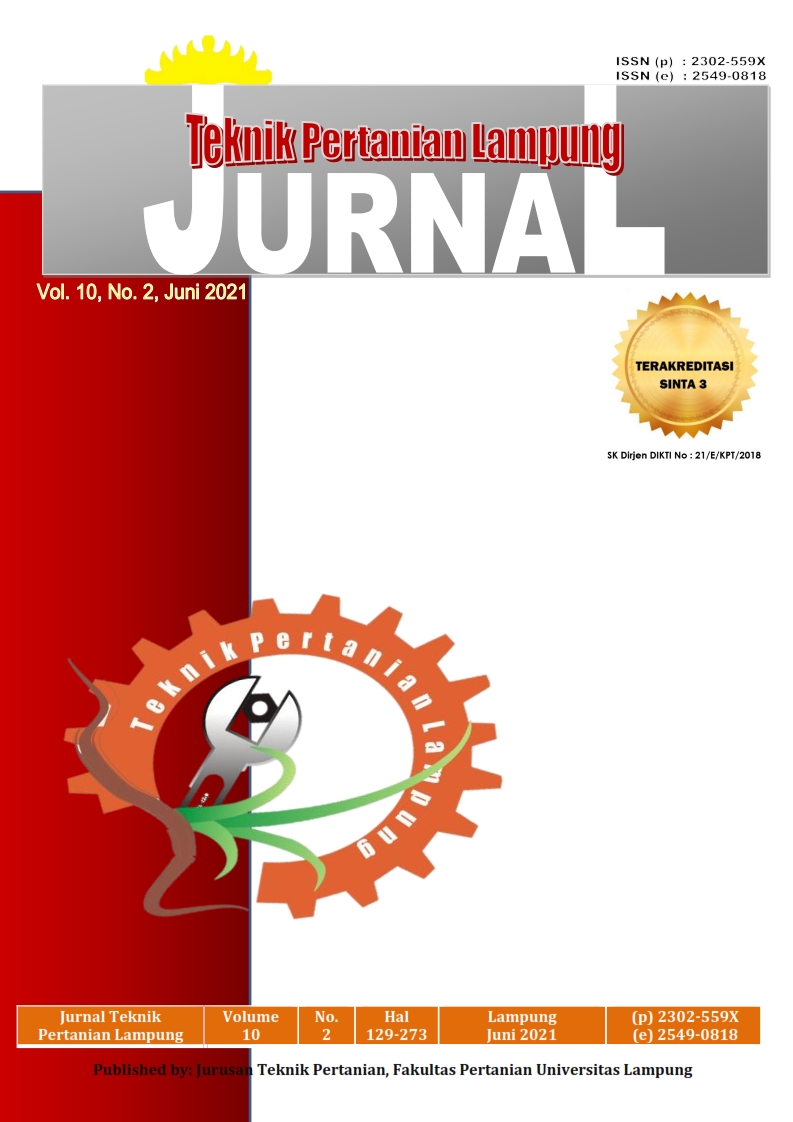PREDIKSI CEPAT KUALITAS AIR MENGGUNAKAN LPAS (LASER PHOTO-ACOUSTIC SPECTROSCOPY) DENGAN MENERAPKAN METODE KOREKSI CUTTING EDGE FILTERING
DOI:
https://doi.org/10.23960/jtep-l.v10i2.220-227Abstract
A tool that can predict water quality by capturing sound vibrations generated by collisions between water samples and light is LPAS (Laser Photo-Acoustic Spectroscopy). To process the data acquired by LPAS, spectrum correction is needed to eliminate data errors when making acquisitions on water samples. The correction method used in this research is the cutting edge filtering correction method. The regression model that can be used is the PLSR (Partial Least Square Regression) regression model. This research was conducted in the Instrumentation and Energy Laboratory, Agricultural Engineering Study Program, Faculty of Agriculture, Syiah Kuala University. Water sample analysis was carried out at the Laboratory of the Industrial Research and Standardization Center (BARISTAND) Banda Aceh. This study used 4 monitoring wells within the TPA (Final Disposal Site) and 4 samples were taken from community wells outside the scope of TPA Gampong Jawa, Banda Aceh City. The results of this study indicate the parameters (temperature, turbidity, Ph, TSS, DO, BOD and Nitrate) are predicted to be in the frequency range 4000 - 10,000 cm-1. Raw spectrum data for pH and Nitrate (NO3-) parameters produce better data than the spectrum data for cutting edge filtering correction methods while cutting edge filtering spectrum data for temperature, turbidity, TSS, DO and BOD-5 parameters are better than spectrum raw data. This study also shows that the cutting edge filtering correction method is able to cut boundaries and compress the spectrum so that it can provide data limits on the spectrum so that the PLSR method can be applied to predict water quality.
Keywords: water quality; Laser Photo-Acoustic Spectroscopy, correction method, regression method
References
Ariwanto, B. 2012. Pendayagunaan Sensor Pergeseran Serat Optik untuk. Pendeteksian Sinyal Fotoakustik pada Bahan Cairan Al(OH)3. [Skripsi]. Departemen Fisika Fakultas Sains dan Teknologi Universitas Airlangga, Surabaya.
Dung NC., Araki H., Yamanishi H., and Koga K. 2005. Simulation of groundwater flow and environmental effects resulting from pumping. Environmental Geology, 47 (3), 361-374
Ibnu, M. S. 2005. Kimia Analitik. JICA. Malang.
Karoui R., A, M. Mouazena, E. Dufourb, L. Pilllonelc, E. Schallerd, J. De Baerdamaekera, dan J.O. Bossetc. 2006. Chemical Characterisation of European Emmental Cheese by Near Infrared Spectroscopy Using Chemometric Tools. International Dairy Journal, 16: 1211-1217.
Knedal, M., Gislum, R., Hermansen, C., Peng, Y., Moldrup, P., De Jonge, L. W., dan Greeve, M.H. 2017. Comparing Predictive Ability of Laser-Induced Break Down Spectroscopy to Visible Near-Infrared Spectroscopy for Soil Property Determination. Biosystem Engineering, 156: 157-172.
Munawar, A.A., Yusmanizar, Syah, H. 2016. Rapid and Simultaneous Detection of Honey Adulteration and Quality Attributes Prediction Using Near Infrared Spectroscopy. AIC-ICMSA conference, 4-6 October 2016.
Nicolai, B.M., K. Buellens, E. Bobelyn, A. Peirs, W. Saeys, K.I. Theron, dan J. Lamertyn. 2007. Nondestructive measurement of fruit and vegetable quality by means of NIR spectroscopy : A review. Postharvest Biology and Technology, 46: 99-118.
Ulva, M.C. 2016, Prediksi Kadar Air Bubuk Biji Kakao Menggunakan NIRS dengan Metode PLS (dengan Pre-Treatment Derivatitive ke 1 dan Mean Centering). [Skripsi]. Teknik Pertanian Universitas Syiah Kuala, Banda Aceh.
Downloads
Published
Issue
Section
License
- Authors who publish with this journal agree to the following terms:
- Authors retain copyright and grant the journal right of first publication with the work simultaneously licensed under a Creative Commons Attribution-ShareAlike 4.0 International Lice that allows others to share the work with an acknowledgement of the work's authorship and initial publication in this journal.
- Authors are able to enter into separate, additional contractual arrangements for the non-exclusive distribution of the journal's published version of the work (e.g., post it to an institutional repository or publish it in a book), with an acknowledgement of its initial publication in this journal.
- Authors are permitted and encouraged to post their work online (e.g., in institutional repositories or on their website) prior to and during the submission process, as it can lead to productive exchanges, as well as earlier and greater citation of published work (See The Effect of Open Access).
Jurnal Teknik Pertanian Lampung

JTEPL is licensed under a Creative Commons Attribution-ShareAlike 4.0 International License.

